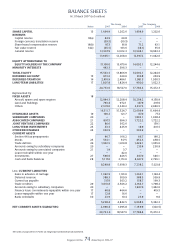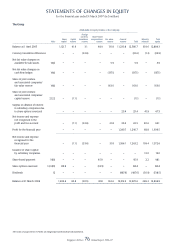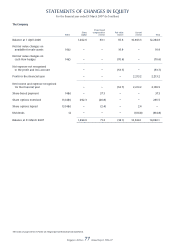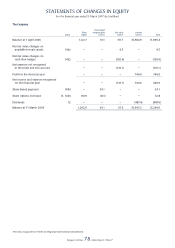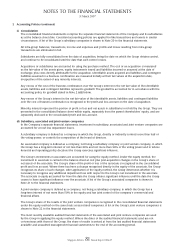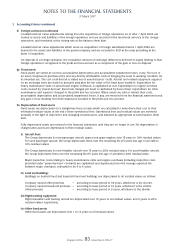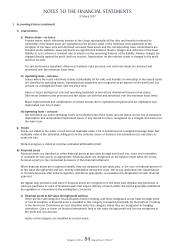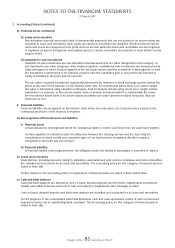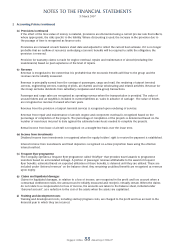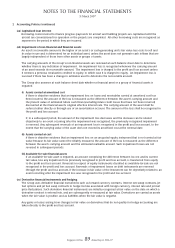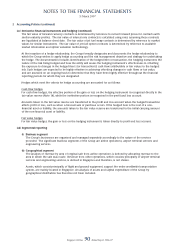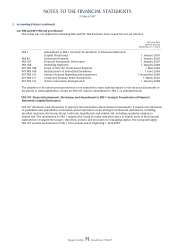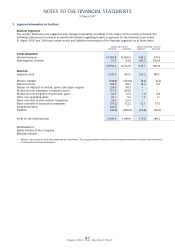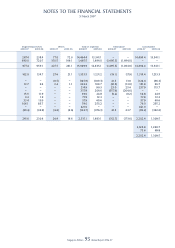Singapore Airlines 2007 Annual Report Download - page 86
Download and view the complete annual report
Please find page 86 of the 2007 Singapore Airlines annual report below. You can navigate through the pages in the report by either clicking on the pages listed below, or by using the keyword search tool below to find specific information within the annual report.Singapore Airlines 84 Annual Report 2006-07
NOTES TO THE FINANCIAL STATEMENTS
31 March 2007
2 Accounting Policies (continued)
(i) Leased assets
(i) Finance lease – as lessee
Finance leases, which effectively transfer to the Group substantially all the risks and benefi ts incidental to
ownership of the leased asset, are capitalised at the present value of the minimum lease payments at the
inception of the lease term and disclosed as leased fi xed assets and the corresponding lease commitments are
included under liabilities. Lease payments are apportioned between fi nance charges and reduction of the lease
liability so as to achieve a constant rate of interest on the remaining balance of the liability. Finance charges are
charged directly against the profi t and loss account. Depreciation on the relevant assets is charged to the profi t
and loss account.
For sale and fi nance leaseback, differences between sales proceeds and net book values are deferred and
amortised over the minimum lease terms.
(ii) Operating lease – as lessee
Leases where the lessor effectively retains substantially all the risks and benefi ts of ownership of the leased assets
are classifi ed as operating leases. Operating lease payments are recognised as an expense in the profi t and loss
account on a straight-line basis over the lease term.
Gains or losses arising from sale and operating leaseback of aircraft are determined based on fair values.
Differences between sales proceeds and fair values are deferred and amortised over the minimum lease terms.
Major improvements and modifi cations to leased aircraft due to operational requirements are capitalised and
depreciated over 4 to 6 years.
(iii) Operating lease – as lessor
Aircraft leased out under operating leases are included under fi xed assets and are stated at cost less accumulated
depreciation and accumulated impairment losses, if any. Rental income is recognised on a straight–line basis over
the lease term.
(j) Stocks
Stocks are stated at the lower of cost and net realisable value. Cost is determined on a weighted average basis. Net
realisable value is the estimated selling price in the ordinary course of business less estimated costs necessary to
make the sale.
Work-in-progress is stated at cost plus estimated attributable profi t.
(k) Financial assets
Financial assets are classifi ed as either fi nancial assets at fair value through profi t and loss, loans and receivables,
or available-for-sale assets, as appropriate. Financial assets are recognised on the balance sheet when the Group
becomes a party to the contractual provisions of the fi nancial instrument.
When fi nancial assets are recognised initially, they are measured at fair value, plus, in the case of fi nancial assets not
at fair value through profi t and loss, directly attributable transaction costs. The Group determines the classifi cations
of its fi nancial assets after initial recognition, and where appropriate, re-evaluates this designation at each fi nancial
year-end.
All regular way purchases and sales of fi nancial assets are recognised on the trade date. Regular way purchases or
sales are purchases or sales of fi nancial assets that require delivery of assets within the period generally established
by regulation or convention in the marketplace concerned.
(i) Financial assets at fair value through profi t and loss
There are two sub-categories: fi nancial assets held for trading, and those designated as fair value through profi t
or loss at inception. A fi nancial asset is classifi ed in this category if acquired principally for the purpose of selling
in the short term. Derivatives are also classifi ed under this category unless they are designated as hedging
derivatives. Gains or losses on fi nancial instruments held at fair value through profi t and loss are recognised in
the profi t and loss account.
Assets in this category are classifi ed as current assets.


